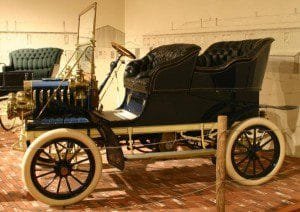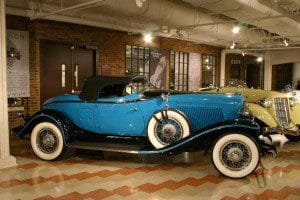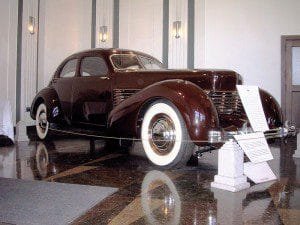Auburn cars, well recognized excellently engineered automobiles, falls into that category of American automakers who didn’t make it through the Great Depression of the 1930’s. As we’ve mentioned in several other articles, the Great Depression presented an entirely new marketing reality and several of the independents had a big challenge and that included the people who built Auburn cars. The larger automakers were able to take advantage of scale and more easily absorb losses. The smaller independents while putting out a quality product had more financial difficulties.

Buggy Makers Become Automakers
The Auburn car was founded back in 1900 by brothers Frank and Morris Eckhart in Auburn Indiana. The first vehicle was more experimental than anything else. Like some of their peers, the brothers had been carriage and buggy builders and had worked for Studebaker. At the turn of the century it wasn’t a great leap to go from carriages to cars. In fact, their first vehicle, built in prior to 1903 was so simple it was a chain drive vehicle with a one cylinder engine costing about $800. There are no solid records available as to how many, if any, of these one cylinder cars sold. Possibly none. When 1903 came around, the Eckhart brothers decided to get more focused on car building. This was the point that they would actually turn it into a business.
The 1904 Auburn was a fancy looking automobile. In fact, during 1904 there were a host of good looking autos such as the Winton, the Knox Touring car and the Buick Touring model. There were several others. There were a slew of eastern automakers producing cars. At this point the cost of getting into the business wasn’t too prohibitive. That of course would change. The 1904 Auburn still had that chain drive and one cylinder engine but this time the car had pneumatic tires. A two cylinder engine was introduced in 1905 and eventually a four cylinder engine was employed in 1909. By 1909 the brothers had also taken over a few other local auto builders. Things were looking up.

Another Pre World War One Auburn of note was the 1916 Model 6-38 Touring Car. This particular car was a four door, seven passenger model with a six cylinder Continental L-Head engine. Auburn engines came a long way since 1904. Like many cars today, the 1916 model came with a 20 gallon fuel tank. The car sold for about $1,375.
The Chicago Investors
The chewing gum king, William Wrigley, and a group of investors including Ralph Bard of Chicago, took over the Auburn nameplate in 1919. The Eckhart brothers were having severe financial problems and decided to sell out. World War One had a negative impact on several automakers. For one thing, materials were in short supply. Wrigley and the Chicago group was in a position to infuse a lot of needed cash into the company. The biggest problem however was that a severe recession hit after World War I, not long after the Chicago investors took over, and the car company was again struggling.
Auburn’s Final Years
When Auburn began struggling in the mid 1920’s, the company took onboard a new leader from a strictly sales background. Automobile salesman Errett Lobban Cord was hired to run the company but actually took it over from the Chicago investors via a leveraged buyout. Cord completed the buyout in 1925. Although Cord knew how to market the Auburn nameplate and partnered with the Dusenberg brand, the Great Depression that began about five years after Cord’s buyout simply made his automobiles too expensive for many. In addition to the Depression, Cord also found himself in trouble with the SEC regarding alleged stock manipulations. As a result of all these troubles production of the Auburn automobile came to a halt in 1937. It never returned.
Two additional photo articles you’ll be interested in are the 1931 Ford Model A Roadster and the 1929 Oakland Motors Sedan.

The second Auburn automobile shown in this article is the 1932 8-100 Speedster Coupe Convertible. The car has the sleek look that Errett Cord was noted for. The engines for these models were eight cylinder with about 100 HP and a top speed of about 100 MPH. There’s no question that the Auburn Speedster was a great looking car with excellent engineering and a lot of power. The Auburn Eights were known for luxury, size and performance. The price of the 1932 models were around $1,000 or a bit higher. This was actually a very low price for the engineering and power that came with it. The price obviously reflected the very tough economic times of the Depression and didn’t really help the financial position of Auburn. Auburn needed to sell cars for more than the price they could get. The Depression ended up taking out both Auburn and Dusenberg. Cord’s SEC troubles likely added to the company’s difficulties.
According to old factory records, it appears that about 6,000 Auburn Eights were produced in 1932.
There’s a great museum located in Auburn Indiana you don’t want to miss. The Auburn Cord Dusenberg Automobile Museum showcases the three old brands and has terrific exhibits. The museum is in the company’s massive old administrative and showroom facility. The address is 1600 South Wayne Street in Auburn.
(Photos from the public domain)